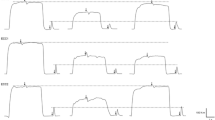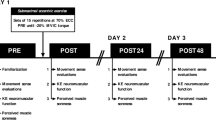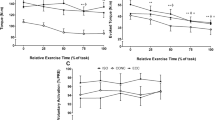Abstract
The objectives of this study were to determine whether the occurrence of delayed onset muscle soreness (DOMS) for the vastus lateralis muscle was associated with elevated intramuscular pressure (IMP); and to assess, whether high eccentric forces occurred at an increased muscle length (as determined by joint angle). Therefore, peak knee extension torque, peak IMP of the vastus lateralis muscle, and the joint angle at which peak torque (JAPT) occurred were determined in eight male subjects during repetitive eccentric and concentric activities until fatigue occurred. Peak torque was significantly higher for eccentric compared to concentric activity (P < 0.01) and declined significantly for both activities (P < 0.01) throughout the protocols. When comparing the start (prior to fatigue) to the end (fatigue state), mean torque for eccentric activity declined from 191 to 147 (N · m) and for concentric activity declined from 166 to 104 (N · m). In contrast, peak IMP was not significantly different between the types of activity and did not change significantly with time. At the start and the end, the mean IMP remained constant for eccentric activity at 54 mmHg (7.2 kPa) but for concentric activity was 78 mmHg (10.4 kPa) and 96 mmHg (12.8 kPa), respectively. All the subjects, however, experienced DOMS of the vastus lateralis muscle exclusively for the eccentric activity leg. The JAPT was not different between activity types and did not change significantly with time; however, a significant interaction between activity type and time was observed (P = 0.01). For eccentric activity JAPT (0° = fully extended leg) was 81° (1.38 rad) and 79° (1.34 rad) and for concentric activity was 76° (1.29 rad) and 83° (1.41 rad) at the start and the end, respectively. From our studies we concluded that during eccentric activity the magnitude of IMP for the vastus lateralis muscle did not reflect the high muscles forces; therefore it would appear that IMP was not an etiologic indicator of DOMS, and that JAPT measurements did not offer an explanation for the high forces which were associated with eccentric activity.
Similar content being viewed by others
References
Aratow M, Ballard RE, Crenshaw AG, Styf J, Watenpaugh DE, Kahan NJ, Hargens AR (1993) Intramuscular pressure and electromyography as indexes of force during isokinetic exercise. J Appl Physiol 74:2634–2640
Bigland-Ritchie B, Woods JJ (1976) Integrated electromyogram and oxygen uptake during positive and negative work. J Physiol (Lond) 260:267–277
Colliander EB, Tesch PA (1989) Bilateral eccentric and concentric torque of quadriceps and hamstring muscles in females and males. Eur J Appl Physiol 59:227–232
Ebbeling CB, Clarkson PM (1989) Exercise-induced muscle damage and adaptation. Sports Med 7:207–234
Fridén J, Lieber RL (1992) Structural and mechanical basis of exercise-induced muscle injury. Med Sci Sports Exerc 24:521–530
Fridén J, Sjöström M, Ekblom B (1983) Myofibrillar damage following intense eccentric exercise in man. Int J Sports Med 4:170–176
Fridén J, Sfakianos PN, Hargens AR (1986) Muscle soreness and intramuscular fluid pressure: comparison between eccentric and concentric load. J Appl Physiol 61:2175–2179
Gray JC, Chandler JM (1989) Percent decline in peak torque production during repeated concentric and eccentric contractions of the quadriceps femoris muscle. J Orthop Sports Phys Ther 10:309–314
Hill AV (1948) The pressure developed in muscle during contraction. J Physiol (Lond) 107:518–526
Hortobágyi T, Katch FI (1990) Eccentric and concentric torque-velocity relationships during arm flexion and extension. Eur J Appl Physiol 60:395–401
Kannus P, Beynnon B (1993) Peak torque occurrence in the range of motion during isokinetic extension and flexion of the knee. Int J Sports Med 14:422–426
Kemp L, Anderson T (1989) Measurement of knee extension torque at angular velocities ranging from 60 to 600° per second (abstract). Int J Sports Med 10:380
Komi PV (1973) Relationship between muscle tension, EMG and velocity of contraction under concentric and eccentric work. In: Desmedt JE (ed) New developments in electromyography and clinical neurophysiology. Karger, Basel, pp 596–606
Komi PV, Rusko H (1974) Quantitative evaluation of mechanical and electrical changes during fatigue loading of eccentric and concentric work. Scand J Rehabi Med [Suppl] 3:121–126
Mazzella H (1954) On the pressure developped by the contraction of striated muscle and its influence on muscular circulation. Arch Int Physiol LXII:334–347
Nakazawa K, Kawakami Y, Fukunaga T, Yano H, Miyashita M (1993) Differences in activation patterns in elbow flexor muscles during isometric, concentric and eccentric contractions. Eur J Appl Physiol 66:214–220
Nardone A, Schieppati M (1988) Shift of activity from slow to fast muscle during voluntary lengthening contractions of the triceps surae muscles in humans. J Physiol 395:363–381
Nardone A, Ramanò C, Schieppati M (1989) Selective recruitment of high-threshold human motor units during voluntary isotonic lengthening of active muscles. J Physiol 409:451–471
Newham DJ, McPhail G, Mills KR, Edwards RHT (1983) Ultrastructural changes after concentric and eccentric contractions of human muscles. J Neurol Sci 61:109–122
Newham DJ, Jones DA, Ghosh G, Aurora P (1988) Muscle fatigue and pain after eccentric contractions at long and short length. Clin Sci 74:553–557
Osternig LR, Sawhill JA, Bates BT, Hamil J (1983) Function of limb speed on torque patterns of antagonist muscles. In: Matsui R, Kobayashi M (eds) Biomechanics VIII-A. Human Kinetics Champaign, Ill., pp 251–257
Sadamoto T, Bonde-Petersen F, Suzuki Y (1983) Skeletal muscle tension, flow, pressure, and EMG during sustained isometric contractions in humans. Eur J Appl Physiol 51:395–408
Sejersted OM, Hargens AR, Kardel KR, Blom P, Jensen Ø, Hermansen L (1984) Intramuscular fluid pressure during isometric contraction of human skeletal muscle. J App] Physiol 56:287–295
Singh M, Karpovich PV (1966) Isotonic and isometric forces of forearm flexors and extensors. J Appl Physiol 21:1435–1437
Jøgaard G, Kiens B, Jørgensen K, Saltin B (1986) Intramuscular pressure, EMG and blood flow during low-level prolonged static contraction in man. Acta Physiol Scand 128:475–484
Smith LL (1991) Acute inflammation: the underlying mechanism in delayed onset muscle soreness? Med Sci Sports Exerc 23:542–551
Stauber WT (1989) Eccentric action of muscles: physiology injury and adaptation. In: Pandolf KP (ed) Exercise and sports sciences reviews. Williams and Wilkins, Baltimore, pp 157–186
Styf JR, Körner LM (1986) Microcapillary infusion technique for measurement of intramuscular pressure during exercise. Clin Orthop 207:253–262
Thorstensson A, Karlsson J (1976) Fatiguability and fibre composition of human skeletal muscle. Acta Physiol Scand 98:318–322
Thorstensson A, Grimby G, Karlsson J (1976) Force-velocity relations and fiber composition in human knee extensor muscles. J Appl Physiol 40:12–16
Westing SH, Seger JY, Karlson E, Ekblom B (1988) Eccentric and concentric torque-velocity characteristics of the quadriceps femoris in man. Eur J Appl Physiol 58:100–104
Westing SH, Cresswell AG, Thorstensson A (1991) Muscle activation during maximal voluntary eccentric and concentric knee extension. Eur J Appl Physiol 62:104–108
Wickiewicz TL, Roy RR, Powell PL, Edgerton VR (1983) Muscle architecture of the human lower limb. Clin Orthop 179:275–283
Author information
Authors and Affiliations
Rights and permissions
About this article
Cite this article
Crenshaw, A.G., Karlsson, S., Styf, J. et al. Knee extension torque and intramuscular pressure of the vastus lateralis muscle during eccentric and concentric activities. Europ. J. Appl. Physiol. 70, 13–19 (1995). https://doi.org/10.1007/BF00601803
Accepted:
Issue Date:
DOI: https://doi.org/10.1007/BF00601803




